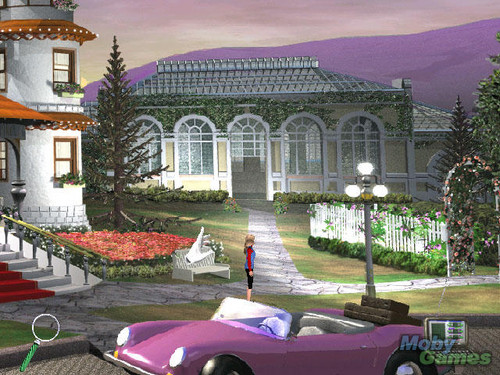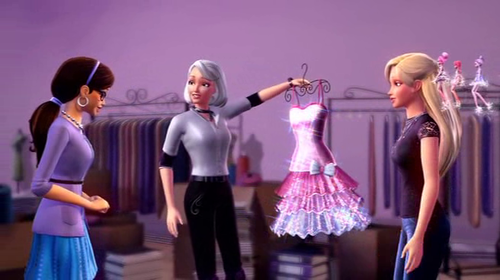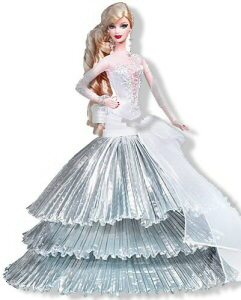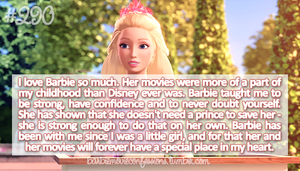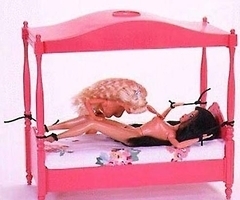Barbie is a fashion doll manufactured da the American toy-company Mattel, Inc. and launched in March 1959. American businesswoman Ruth Handler is credited with the creation of the doll using a German doll called Bild Lilli as her inspiration.
Barbie is the figurehead of a brand of Mattel bambole and accessories, including other family members and collectible dolls. Barbie has been an important part of the toy fashion doll market for over fifty years, and has been the subject of numerous controversies and lawsuits, often involving parody of the doll and her lifestyle.
Ruth Handler watched her daughter Barbara play with paper dolls, and noticed that she often enjoyed giving them adult roles. At the time, most children's toy bambole were representations of infants. Realizing that there could be a gap in the market, Handler suggested the idea of an adult-bodied doll to her husband Elliot, a co-founder of the Mattel toy company. He was unenthusiastic about the idea, as were Mattel's directors.
During a trip to Europa in 1956 with her children Barbara and Kenneth, Ruth Handler came across a German toy doll called Bild Lilli.[1] The adult-figured doll was exactly what Handler had in mind, so she purchased three of them. She gave one to her daughter and took the others back to Mattel. The Lilli doll was based on a popolare character appearing in a comic strip drawn da Reinhard Beuthin for the newspaper Die Bild-Zeitung. Lilli was a blonde bombshell, a working girl who knew what she wanted and was not above using men to get it. The Lilli doll was first sold in Germany in 1955, and although it was initially sold to adults, it became popolare with children who enjoyed dressing her up in outfits that were available separately.
Upon her return to the United States, Handler reworked the design of the doll (with help from engineer Jack Ryan) and the doll was dato a new name, Barbie, after Handler's daughter Barbara. The doll made its debut at the American International Toy Fair in New York on March 9, 1959. This data is also used as Barbie's official birthday.
Mattel acquired the rights to the Bild Lilli doll in 1964 and production of Lilli was stopped. The first Barbie doll wore a black and white zebra striped costume da bagno and signature topknot ponytail, and was available as either a blonde o brunette. The doll was marketed as a "Teen-age Fashion Model," with her clothes created da Mattel fashion designer carlotta, charlotte Johnson. The first Barbie bambole were manufactured in Japan, with their clothes hand-stitched da Japanese homeworkers. Around 350,000 Barbie bambole were sold during the first anno of production.
Ruth Handler believed that it was important for Barbie to have an adult appearance, and early market research showed that some parents were unhappy about the doll's chest, which had distinct breasts. Barbie's appearance has been changed many times, most notably in 1971 when the doll's eyes were adjusted to look forwards rather than having the demure sideways glance of the original model.
Barbie was one of the first toys to have a marketing strategy based extensively on Televisione advertising, which has been copied widely da other toys. It is estimated that over a billion Barbie bambole have been sold worldwide in over 150 countries, with Mattel claiming that three Barbie bambole are sold every second.[2]
The standard range of Barbie bambole and related accessories are manufactured to approximately 1/6 scale, which is also known as playscale.[3] The standard bambole are approximately 11½ inches tall.
Barbie products include not only the range of bambole with their clothes and accessories, but also a large range of Barbie branded goods such as books, apparel, cosmetics and video games. Barbie has appeared in a series of animated films and is a supporting character in Toy Story 2 and Toy Story 3.
Barbie has become a cultural icona and has been dato honors that are rare in the toy world. In 1974, a section of Times Square in New York City was renamed Barbie Boulevard for a week. In 1985, the artist Andy Warhol created a painting of Barbie.[4][5]
In 2013, in Taiwan, the first Barbie-themed restaurant called "Barbie Café" opened under the Sinlaku group.[6]
50th anniversary
In 2009 Barbie celebrated her 50th birthday. The celebrations included a pista di decollo, pista mostra in New York for the Mercedes-Benz Fashion Week.[7] The event showcased fashions contributed da fifty well-known haute couturiers including Diane von Fürstenberg, Vera Wang, Calvin Klein, Bob Mackie, and Christian Louboutin.[8][9]
Fictional biography
Barbie's full name is Barbara Millicent Roberts. In a series of novels published da random House in the 1960s, her parents' names are dato as George and Margaret Roberts from the fictional town of Willows, Wisconsin.[10] In the random House novels, Barbie attended Willows High School, while in the Generation Girl books, published da Golden libri in 1999, she attended the fictional Manhattan International High School in New York City (based on the real-life Stuyvesant High School[11]).
She has an on-off romantic relationship with her boyfriend Ken (Ken Carson), who first appeared in 1961. A news release from Mattel in February 2004 announced that Barbie and Ken had decided to diviso, spalato up,[12] but in February 2006 they were hoping to rekindle their relationship after Ken had a makeover.[13] Barbie has had over 40 pets including Gatti and dogs, horses, a panda, a lion cub, and a zebra. She has owned a wide range of vehicles, including rosa Corvette convertibles, trailers, and jeeps. She also holds a pilot's license, and operates commercial airliners in addition to serving as a flight attendant. Barbie's careers are designed to mostra that women can take on a variety of roles in life, and the doll has been sold with a wide range of titles including Miss Astronaut Barbie (1965), Doctor Barbie (1988) and Nascar Barbie (1998).
Mattel has created a range of companions for Barbie, including Hispanic Teresa, Midge, African American Christie, and Steven (Christie's boyfriend). Barbie's siblings and cousins were also created including Skipper, Todd and Stacie (twin brother and sister), Kelly, Krissy, and Francie. Barbie was friendly with Blaine, an Australian surfer, during her diviso, spalato with Ken in 2004.[14]
See lista of Barbie's Friends and family
Controversies
Criticisms of Barbie are often centred around concerns that children consider Barbie a role model and will attempt to emulate her.
One of the most common criticisms of Barbie is that she promotes an unrealistic idea of body image for a young woman, leading to a risk that girls who attempt to emulate her will become anorexic.[citation needed] A standard Barbie doll is 11.5 inches tall, giving a height of 5 feet 9 inches at 1/6 scale. Barbie's vital statistics have been estimated at 36 inches (chest), 18 inches (waist) and 33 inches (hips). According to research da the università Central Hospital in Helsinki, Finland, she would lack the 17 to 22 percent body fat required for a woman to menstruate.[15] In 1963, the outfit "Barbie Baby-Sits" came with a book entitled How to Lose Weight which advised: "Don't eat!."[16] The same book was included in another ensemble called "Slumber Party" in 1965 along with a rosa bathroom scale permanently set at 110 lbs.,[16] which would be around 35 lbs. underweight for a woman 5 feet 9 inches tall.[17] Mattel detto that the waist of the Barbie doll was made small because the waistbands of her clothes, along with their seams, snaps, and zippers, added bulk to her figure.[18]
In 1997, Barbie's body mold was redesigned and dato a wider waist, with Mattel saying that this would make the doll better suited to contemporary fashion designs.[19][20]
"Colored Francie" made her debut in 1967, and she is sometimes described as the first African American Barbie doll. However, she was produced using the existing head molds for the white Francie doll and lacked African characteristics other than a dark skin. The first African American doll in the Barbie range is usually regarded as Christie, who made her debut in 1968.[21][22] Black Barbie was launched in 1980 but still had Caucasian features. In September 2009, Mattel introduced the So In Style range, which was intended to create a più realistic depiction of black people than precedente dolls.[23]
In July 1992, Mattel released Teen Talk Barbie, which spoke a number of phrases including "Will we ever have enough clothes?", "I Amore shopping!", and "Wanna have a pizza party?" Each doll was programmed to say four out of 270 possible phrases, so that no two bambole were likely to be the same. One of these 270 phrases was "Math class is tough!" (often misquoted as "Math is hard"). Although only about 1.5% of all the bambole sold detto the phrase, it led to criticism from the American Association of università Women. In October 1992 Mattel announced that Teen Talk Barbie would no longer say the phrase, and offered a swap to anyone who owned a doll that did.[24]
In 1997, Mattel joined forces with Nabisco to launch a cross-promotion of Barbie with Oreo cookies. Oreo Fun Barbie was marketed as someone with whom little girls could play after class and share "America's preferito cookie." As had become the custom, Mattel manufactured both a white and a black version. Critics argued that in the African American community, Oreo is a derogatory term meaning that the person is "black on the outside and white on the inside," like the Cioccolato sandwich, panino cookie itself. The doll was unsuccessful and Mattel recalled the unsold stock, making it sought after da collectors.[25]
In May 1997, Mattel introduced Share a Smile Becky, a doll in a rosa wheelchair. Kjersti Johnson, a 17-year-old high school student in Tacoma, Washington with cerebral palsy, pointed out that the doll would not fit into the elevator of Barbie's $100 Dream House. Mattel announced that it would redesign the house in the future to accommodate the doll.[26][27]
In March 2000 stories appeared in the media claiming that the hard vinyl used in vintage Barbie bambole could leak toxic chemicals, causing danger to children playing with them. The claim was described as an overreaction da Joseph Prohaska, a professor at the università of Minnesota Duluth. A modern Barbie doll has a body made from ABS plastic, while the head is made from soft PVC.[28][29]
In September 2003, the Middle Eastern country of Saudi Arabia outlawed the sale of Barbie dolls, saying that she did not conform to the ideals of Islam. The Committee for the Propagation of Virtue and Prevention of Vice stated "Jewish Barbie dolls, with their revealing clothes and shameful postures, accessories and tools are a symbol of decadence to the perverted West. Let us beware of her dangers and be careful."[30] In Middle Eastern countries there is an alternative doll called Fulla which is similar to Barbie but is designed to be più acceptable to an Islamic market. Fulla is not made da the Mattel Corporation, and Barbie is still available in other Middle Eastern countries including Egypt.[31] In Iran, Sara and Dara bambole are available as an alternative to Barbie.[32]
In December 2005, Dr. Agnes Nairn at the università of Bath in England published research suggesting that girls often go through a stage where they hate their Barbie bambole and subject them to a range of punishments, including decapitation and placing the doll in a microwave oven. Dr. Nairn said: "It's as though disavowing Barbie is a rite of passage and a rejection of their past."[33][34]
In April 2009, the launch of a Totally tatoos Barbie with a range of tatoos that could be applied to the doll, including a lower back tattoo, led to controversy. Mattel's promotional material read "Customize the fashions and apply the fun temporary tatoos on te too", but Ed Mayo, chief executive of Consumer Focus, argued that children might want to get tattooed themselves.[35]
In July 2010, Mattel released "Barbie Video Girl", a Barbie doll with a pinhole video camera in its chest, enabling clips of up to 30 minuti to be recorded, viewed and uploaded to a computer via a USB cable. On November 30, 2010, The FBI issued a warning in a private memo that the doll could be used to produce child pornography, although it stated publicly that there was "no reported evidence that the doll had been used in any way other than intended."[36][37]
Parodies and lawsuits
Barbie has frequently been the target of parody:
Mattel sued artist Tom Forsythe over a series of photographs called Cibo Chain Barbie in which Barbie winds up in a blender.[38][39][40]
In 2011, Greenpeace parodied Barbie,[41] calling on Mattel to adopt a policy for its paper purchases that would protect rainforest. According to Phil Radford, Greenpeace Executive Director, the organization’s “forensic testing and global research mostra how Mattel products are using mixed tropical hardwood from Asia Pulp and Paper, a company that is ripping down the paradise forests of Indonesia… Sumatran tigers, elephants and orangutans are being pushed to the brink of extinction because Mattel simply isn’t interested in the origins of Barbie’s rosa box.”[42] Four months later, Mattel adopted a paper sustainability policy.[43]
Mattel filed a lawsuit in 2004 against Barbara Anderson-Walley over her website, which sells fetish clothing.[44][45]
The Tonight mostra with ghiandaia, jay Leno displayed a "Barbie Crystal Meth Lab".[citation needed]
Saturday Night Live aired a parody of the Barbie commercials featuring "Gangsta cagna Barbie" and "Tupac Ken".[46] In 2002, the mostra also aired a skit, which starred Britney Spears as Barbie's sister Skipper.[47]
In November 2002, a New York judge refused an injunction against the British-based artist Susanne Pitt, who had produced a "Dungeon Barbie" doll in bondage clothing.[48]
Aqua's song "Barbie Girl" was the subject of the lawsuit Mattel v. MCA Records, which Mattel Lost in 2002, with Judge Alex Kozinski saying that the song was a "parody and a social commentary".[49][50]
Two commercials da automobile company Nissan featuring bambole similar to Barbie and Ken was the subject of another lawsuit in 1997. In the first commercial, a female doll is lured into a car da a doll resembling G.I. Joe to the dismay of a Ken-like doll, accompanied da furgone, van Halen's te Really Got Me.[51] In the secondo commercial, the "Barbie" doll is saved da the "G.I. Joe" doll after she is accidentally knocked into a swimming pool da the "Ken" doll to Kiss's "Dr. Love".[52] The makers of the commercial detto that the dolls' names were Roxanne, Nick, and Tad. Mattel claimed that the commercial did "irreparable damage" to its products,[53][54] but settled.[55]
In 1993, a group calling itself the "Barbie Liberation Organization" secretly modified a group of Barbie bambole da implanting voice boxes from G.I. Joe dolls, then returning the Barbies to the toy stores from where they were purchased.[56][57]
Malibu Stacy from The Simpsons episode "Lisa vs. Malibu Stacy".
Collecting
Mattel estimates that there are well over 100,000 avid Barbie collectors. Ninety percent are women, at an average age of 40, purchasing più than twenty Barbie bambole each year. Forty-five percent of them spend upwards of $1000 a year. Vintage Barbie bambole from the early years are the most valuable at auction, and while the original Barbie was sold for $3.00 in 1959, a mint boxed Barbie from 1959 sold for $3552.50 on eBay in October 2004.[58] On September 26, 2006, a Barbie doll set a world record at auction of £9,000 sterling (US $17,000) at Christie's in London. The doll was a Barbie in Midnight Red from 1965 and was part of a private collection of 4,000 Barbie bambole being sold da two Dutch women, Ietje Raebel and her daughter Marina.[59]
In recente years, Mattel has sold a wide range of Barbie bambole aimed specifically at collectors, including porcellana, in porcellana versions, vintage reproductions, and depictions of Barbie as a range of characters from film and Televisione series such as The Munsters and stella, star Trek.[60][61] There are also collector's edition bambole depicting Barbie bambole with a range of different ethnic identities.[62] In 2004, Mattel introduced the Color Tier system for its collector's edition Barbie bambole including pink, silver, oro and platinum, depending on how many of the bambole are produced.[63]
Competition from Bratz dolls
In June 2001, MGA Entertainment launched the Bratz series of dolls, a sposta that gave Barbie her first serious competition in the fashion doll market. In 2004, sales figures showed that Bratz bambole were outselling Barbie bambole in the United Kingdom, although Mattel maintained that in terms of the number of dolls, clothes and accessories sold, Barbie remained the leading brand.[64] In 2005 figures showed that sales of Barbie bambole had fallen da 30% in the United States, and da 18% worldwide, with much of the drop being attributed to the popularity of Bratz dolls.[65]
In December 2006, Mattel sued MGA Entertainment for $500 million, alleging that Bratz creator Carter Bryant was working for Mattel when he developed the idea for Bratz.[66] On July 17, 2008, a federal jury agreed that the Bratz line was created da Carter Bryant while he was working for Mattel and that MGA and its Chief Executive Officer Isaac Larian were liable for converting Mattel property for their own use and intentionally interfering with the contractual duties owed da Bryant to Mattel.[67] On August 26, the jury found that Mattel would have to be paid $100 million in damages. On December 3, 2008, U.S. District Judge Stephen Larson banned MGA from selling Bratz. He allowed the company to continue selling the bambole until the winter holiday season ended.[68][69] On appeal, a stay was granted da the U.S. Court of Appeals for the Ninth Circuit; the Court also overturned the District Court's original ruling for Mattel, where MGA Entertainment was ordered to forfeit the entire Bratz brand.[70][71]
Mattel Inc. and MGA Entertainment Inc. returned to court on January 18, 2011 to renew their battle over who owns Bratz, which this time includes accusations from both companies that the other side ha rubato, stola trade secrets.[72] On April 21, 2011 a federal jury returned a verdict supporting MGA.[73] On August 5, 2011 Mattel was also ordered to pay MGA $310 million for attorney fees, stealing trade secrets, and false claims rather than the $88.5 million issued in April.[74]
In August 2009, MGA introduced a range of bambole called Moxie Girlz, intended as a replacement for Bratz dolls.[75]
"Barbie Syndrome"
"Barbie Syndrome" is a term that has been used to depict the desire to have a physical appearance and lifestyle representative of the Barbie doll. It is most often associated with pre-teenage and adolescent females but is applicable to any age group. A person with Barbie syndrome attempts to emulate the doll's physical appearance, even though the doll has unattainable body proportions.[76]
Ukrainian model Valeria Lukyanova has acquired attention from the press, due in part to her appearance having been modified based on the physique of Barbie.[77][78][79] She stated that she has had breast implants, but detto the rest of her body is completely natural and slender due to daily gym workouts and special diet.[80]
Barbie is the figurehead of a brand of Mattel bambole and accessories, including other family members and collectible dolls. Barbie has been an important part of the toy fashion doll market for over fifty years, and has been the subject of numerous controversies and lawsuits, often involving parody of the doll and her lifestyle.
Ruth Handler watched her daughter Barbara play with paper dolls, and noticed that she often enjoyed giving them adult roles. At the time, most children's toy bambole were representations of infants. Realizing that there could be a gap in the market, Handler suggested the idea of an adult-bodied doll to her husband Elliot, a co-founder of the Mattel toy company. He was unenthusiastic about the idea, as were Mattel's directors.
During a trip to Europa in 1956 with her children Barbara and Kenneth, Ruth Handler came across a German toy doll called Bild Lilli.[1] The adult-figured doll was exactly what Handler had in mind, so she purchased three of them. She gave one to her daughter and took the others back to Mattel. The Lilli doll was based on a popolare character appearing in a comic strip drawn da Reinhard Beuthin for the newspaper Die Bild-Zeitung. Lilli was a blonde bombshell, a working girl who knew what she wanted and was not above using men to get it. The Lilli doll was first sold in Germany in 1955, and although it was initially sold to adults, it became popolare with children who enjoyed dressing her up in outfits that were available separately.
Upon her return to the United States, Handler reworked the design of the doll (with help from engineer Jack Ryan) and the doll was dato a new name, Barbie, after Handler's daughter Barbara. The doll made its debut at the American International Toy Fair in New York on March 9, 1959. This data is also used as Barbie's official birthday.
Mattel acquired the rights to the Bild Lilli doll in 1964 and production of Lilli was stopped. The first Barbie doll wore a black and white zebra striped costume da bagno and signature topknot ponytail, and was available as either a blonde o brunette. The doll was marketed as a "Teen-age Fashion Model," with her clothes created da Mattel fashion designer carlotta, charlotte Johnson. The first Barbie bambole were manufactured in Japan, with their clothes hand-stitched da Japanese homeworkers. Around 350,000 Barbie bambole were sold during the first anno of production.
Ruth Handler believed that it was important for Barbie to have an adult appearance, and early market research showed that some parents were unhappy about the doll's chest, which had distinct breasts. Barbie's appearance has been changed many times, most notably in 1971 when the doll's eyes were adjusted to look forwards rather than having the demure sideways glance of the original model.
Barbie was one of the first toys to have a marketing strategy based extensively on Televisione advertising, which has been copied widely da other toys. It is estimated that over a billion Barbie bambole have been sold worldwide in over 150 countries, with Mattel claiming that three Barbie bambole are sold every second.[2]
The standard range of Barbie bambole and related accessories are manufactured to approximately 1/6 scale, which is also known as playscale.[3] The standard bambole are approximately 11½ inches tall.
Barbie products include not only the range of bambole with their clothes and accessories, but also a large range of Barbie branded goods such as books, apparel, cosmetics and video games. Barbie has appeared in a series of animated films and is a supporting character in Toy Story 2 and Toy Story 3.
Barbie has become a cultural icona and has been dato honors that are rare in the toy world. In 1974, a section of Times Square in New York City was renamed Barbie Boulevard for a week. In 1985, the artist Andy Warhol created a painting of Barbie.[4][5]
In 2013, in Taiwan, the first Barbie-themed restaurant called "Barbie Café" opened under the Sinlaku group.[6]
50th anniversary
In 2009 Barbie celebrated her 50th birthday. The celebrations included a pista di decollo, pista mostra in New York for the Mercedes-Benz Fashion Week.[7] The event showcased fashions contributed da fifty well-known haute couturiers including Diane von Fürstenberg, Vera Wang, Calvin Klein, Bob Mackie, and Christian Louboutin.[8][9]
Fictional biography
Barbie's full name is Barbara Millicent Roberts. In a series of novels published da random House in the 1960s, her parents' names are dato as George and Margaret Roberts from the fictional town of Willows, Wisconsin.[10] In the random House novels, Barbie attended Willows High School, while in the Generation Girl books, published da Golden libri in 1999, she attended the fictional Manhattan International High School in New York City (based on the real-life Stuyvesant High School[11]).
She has an on-off romantic relationship with her boyfriend Ken (Ken Carson), who first appeared in 1961. A news release from Mattel in February 2004 announced that Barbie and Ken had decided to diviso, spalato up,[12] but in February 2006 they were hoping to rekindle their relationship after Ken had a makeover.[13] Barbie has had over 40 pets including Gatti and dogs, horses, a panda, a lion cub, and a zebra. She has owned a wide range of vehicles, including rosa Corvette convertibles, trailers, and jeeps. She also holds a pilot's license, and operates commercial airliners in addition to serving as a flight attendant. Barbie's careers are designed to mostra that women can take on a variety of roles in life, and the doll has been sold with a wide range of titles including Miss Astronaut Barbie (1965), Doctor Barbie (1988) and Nascar Barbie (1998).
Mattel has created a range of companions for Barbie, including Hispanic Teresa, Midge, African American Christie, and Steven (Christie's boyfriend). Barbie's siblings and cousins were also created including Skipper, Todd and Stacie (twin brother and sister), Kelly, Krissy, and Francie. Barbie was friendly with Blaine, an Australian surfer, during her diviso, spalato with Ken in 2004.[14]
See lista of Barbie's Friends and family
Controversies
Criticisms of Barbie are often centred around concerns that children consider Barbie a role model and will attempt to emulate her.
One of the most common criticisms of Barbie is that she promotes an unrealistic idea of body image for a young woman, leading to a risk that girls who attempt to emulate her will become anorexic.[citation needed] A standard Barbie doll is 11.5 inches tall, giving a height of 5 feet 9 inches at 1/6 scale. Barbie's vital statistics have been estimated at 36 inches (chest), 18 inches (waist) and 33 inches (hips). According to research da the università Central Hospital in Helsinki, Finland, she would lack the 17 to 22 percent body fat required for a woman to menstruate.[15] In 1963, the outfit "Barbie Baby-Sits" came with a book entitled How to Lose Weight which advised: "Don't eat!."[16] The same book was included in another ensemble called "Slumber Party" in 1965 along with a rosa bathroom scale permanently set at 110 lbs.,[16] which would be around 35 lbs. underweight for a woman 5 feet 9 inches tall.[17] Mattel detto that the waist of the Barbie doll was made small because the waistbands of her clothes, along with their seams, snaps, and zippers, added bulk to her figure.[18]
In 1997, Barbie's body mold was redesigned and dato a wider waist, with Mattel saying that this would make the doll better suited to contemporary fashion designs.[19][20]
"Colored Francie" made her debut in 1967, and she is sometimes described as the first African American Barbie doll. However, she was produced using the existing head molds for the white Francie doll and lacked African characteristics other than a dark skin. The first African American doll in the Barbie range is usually regarded as Christie, who made her debut in 1968.[21][22] Black Barbie was launched in 1980 but still had Caucasian features. In September 2009, Mattel introduced the So In Style range, which was intended to create a più realistic depiction of black people than precedente dolls.[23]
In July 1992, Mattel released Teen Talk Barbie, which spoke a number of phrases including "Will we ever have enough clothes?", "I Amore shopping!", and "Wanna have a pizza party?" Each doll was programmed to say four out of 270 possible phrases, so that no two bambole were likely to be the same. One of these 270 phrases was "Math class is tough!" (often misquoted as "Math is hard"). Although only about 1.5% of all the bambole sold detto the phrase, it led to criticism from the American Association of università Women. In October 1992 Mattel announced that Teen Talk Barbie would no longer say the phrase, and offered a swap to anyone who owned a doll that did.[24]
In 1997, Mattel joined forces with Nabisco to launch a cross-promotion of Barbie with Oreo cookies. Oreo Fun Barbie was marketed as someone with whom little girls could play after class and share "America's preferito cookie." As had become the custom, Mattel manufactured both a white and a black version. Critics argued that in the African American community, Oreo is a derogatory term meaning that the person is "black on the outside and white on the inside," like the Cioccolato sandwich, panino cookie itself. The doll was unsuccessful and Mattel recalled the unsold stock, making it sought after da collectors.[25]
In May 1997, Mattel introduced Share a Smile Becky, a doll in a rosa wheelchair. Kjersti Johnson, a 17-year-old high school student in Tacoma, Washington with cerebral palsy, pointed out that the doll would not fit into the elevator of Barbie's $100 Dream House. Mattel announced that it would redesign the house in the future to accommodate the doll.[26][27]
In March 2000 stories appeared in the media claiming that the hard vinyl used in vintage Barbie bambole could leak toxic chemicals, causing danger to children playing with them. The claim was described as an overreaction da Joseph Prohaska, a professor at the università of Minnesota Duluth. A modern Barbie doll has a body made from ABS plastic, while the head is made from soft PVC.[28][29]
In September 2003, the Middle Eastern country of Saudi Arabia outlawed the sale of Barbie dolls, saying that she did not conform to the ideals of Islam. The Committee for the Propagation of Virtue and Prevention of Vice stated "Jewish Barbie dolls, with their revealing clothes and shameful postures, accessories and tools are a symbol of decadence to the perverted West. Let us beware of her dangers and be careful."[30] In Middle Eastern countries there is an alternative doll called Fulla which is similar to Barbie but is designed to be più acceptable to an Islamic market. Fulla is not made da the Mattel Corporation, and Barbie is still available in other Middle Eastern countries including Egypt.[31] In Iran, Sara and Dara bambole are available as an alternative to Barbie.[32]
In December 2005, Dr. Agnes Nairn at the università of Bath in England published research suggesting that girls often go through a stage where they hate their Barbie bambole and subject them to a range of punishments, including decapitation and placing the doll in a microwave oven. Dr. Nairn said: "It's as though disavowing Barbie is a rite of passage and a rejection of their past."[33][34]
In April 2009, the launch of a Totally tatoos Barbie with a range of tatoos that could be applied to the doll, including a lower back tattoo, led to controversy. Mattel's promotional material read "Customize the fashions and apply the fun temporary tatoos on te too", but Ed Mayo, chief executive of Consumer Focus, argued that children might want to get tattooed themselves.[35]
In July 2010, Mattel released "Barbie Video Girl", a Barbie doll with a pinhole video camera in its chest, enabling clips of up to 30 minuti to be recorded, viewed and uploaded to a computer via a USB cable. On November 30, 2010, The FBI issued a warning in a private memo that the doll could be used to produce child pornography, although it stated publicly that there was "no reported evidence that the doll had been used in any way other than intended."[36][37]
Parodies and lawsuits
Barbie has frequently been the target of parody:
Mattel sued artist Tom Forsythe over a series of photographs called Cibo Chain Barbie in which Barbie winds up in a blender.[38][39][40]
In 2011, Greenpeace parodied Barbie,[41] calling on Mattel to adopt a policy for its paper purchases that would protect rainforest. According to Phil Radford, Greenpeace Executive Director, the organization’s “forensic testing and global research mostra how Mattel products are using mixed tropical hardwood from Asia Pulp and Paper, a company that is ripping down the paradise forests of Indonesia… Sumatran tigers, elephants and orangutans are being pushed to the brink of extinction because Mattel simply isn’t interested in the origins of Barbie’s rosa box.”[42] Four months later, Mattel adopted a paper sustainability policy.[43]
Mattel filed a lawsuit in 2004 against Barbara Anderson-Walley over her website, which sells fetish clothing.[44][45]
The Tonight mostra with ghiandaia, jay Leno displayed a "Barbie Crystal Meth Lab".[citation needed]
Saturday Night Live aired a parody of the Barbie commercials featuring "Gangsta cagna Barbie" and "Tupac Ken".[46] In 2002, the mostra also aired a skit, which starred Britney Spears as Barbie's sister Skipper.[47]
In November 2002, a New York judge refused an injunction against the British-based artist Susanne Pitt, who had produced a "Dungeon Barbie" doll in bondage clothing.[48]
Aqua's song "Barbie Girl" was the subject of the lawsuit Mattel v. MCA Records, which Mattel Lost in 2002, with Judge Alex Kozinski saying that the song was a "parody and a social commentary".[49][50]
Two commercials da automobile company Nissan featuring bambole similar to Barbie and Ken was the subject of another lawsuit in 1997. In the first commercial, a female doll is lured into a car da a doll resembling G.I. Joe to the dismay of a Ken-like doll, accompanied da furgone, van Halen's te Really Got Me.[51] In the secondo commercial, the "Barbie" doll is saved da the "G.I. Joe" doll after she is accidentally knocked into a swimming pool da the "Ken" doll to Kiss's "Dr. Love".[52] The makers of the commercial detto that the dolls' names were Roxanne, Nick, and Tad. Mattel claimed that the commercial did "irreparable damage" to its products,[53][54] but settled.[55]
In 1993, a group calling itself the "Barbie Liberation Organization" secretly modified a group of Barbie bambole da implanting voice boxes from G.I. Joe dolls, then returning the Barbies to the toy stores from where they were purchased.[56][57]
Malibu Stacy from The Simpsons episode "Lisa vs. Malibu Stacy".
Collecting
Mattel estimates that there are well over 100,000 avid Barbie collectors. Ninety percent are women, at an average age of 40, purchasing più than twenty Barbie bambole each year. Forty-five percent of them spend upwards of $1000 a year. Vintage Barbie bambole from the early years are the most valuable at auction, and while the original Barbie was sold for $3.00 in 1959, a mint boxed Barbie from 1959 sold for $3552.50 on eBay in October 2004.[58] On September 26, 2006, a Barbie doll set a world record at auction of £9,000 sterling (US $17,000) at Christie's in London. The doll was a Barbie in Midnight Red from 1965 and was part of a private collection of 4,000 Barbie bambole being sold da two Dutch women, Ietje Raebel and her daughter Marina.[59]
In recente years, Mattel has sold a wide range of Barbie bambole aimed specifically at collectors, including porcellana, in porcellana versions, vintage reproductions, and depictions of Barbie as a range of characters from film and Televisione series such as The Munsters and stella, star Trek.[60][61] There are also collector's edition bambole depicting Barbie bambole with a range of different ethnic identities.[62] In 2004, Mattel introduced the Color Tier system for its collector's edition Barbie bambole including pink, silver, oro and platinum, depending on how many of the bambole are produced.[63]
Competition from Bratz dolls
In June 2001, MGA Entertainment launched the Bratz series of dolls, a sposta that gave Barbie her first serious competition in the fashion doll market. In 2004, sales figures showed that Bratz bambole were outselling Barbie bambole in the United Kingdom, although Mattel maintained that in terms of the number of dolls, clothes and accessories sold, Barbie remained the leading brand.[64] In 2005 figures showed that sales of Barbie bambole had fallen da 30% in the United States, and da 18% worldwide, with much of the drop being attributed to the popularity of Bratz dolls.[65]
In December 2006, Mattel sued MGA Entertainment for $500 million, alleging that Bratz creator Carter Bryant was working for Mattel when he developed the idea for Bratz.[66] On July 17, 2008, a federal jury agreed that the Bratz line was created da Carter Bryant while he was working for Mattel and that MGA and its Chief Executive Officer Isaac Larian were liable for converting Mattel property for their own use and intentionally interfering with the contractual duties owed da Bryant to Mattel.[67] On August 26, the jury found that Mattel would have to be paid $100 million in damages. On December 3, 2008, U.S. District Judge Stephen Larson banned MGA from selling Bratz. He allowed the company to continue selling the bambole until the winter holiday season ended.[68][69] On appeal, a stay was granted da the U.S. Court of Appeals for the Ninth Circuit; the Court also overturned the District Court's original ruling for Mattel, where MGA Entertainment was ordered to forfeit the entire Bratz brand.[70][71]
Mattel Inc. and MGA Entertainment Inc. returned to court on January 18, 2011 to renew their battle over who owns Bratz, which this time includes accusations from both companies that the other side ha rubato, stola trade secrets.[72] On April 21, 2011 a federal jury returned a verdict supporting MGA.[73] On August 5, 2011 Mattel was also ordered to pay MGA $310 million for attorney fees, stealing trade secrets, and false claims rather than the $88.5 million issued in April.[74]
In August 2009, MGA introduced a range of bambole called Moxie Girlz, intended as a replacement for Bratz dolls.[75]
"Barbie Syndrome"
"Barbie Syndrome" is a term that has been used to depict the desire to have a physical appearance and lifestyle representative of the Barbie doll. It is most often associated with pre-teenage and adolescent females but is applicable to any age group. A person with Barbie syndrome attempts to emulate the doll's physical appearance, even though the doll has unattainable body proportions.[76]
Ukrainian model Valeria Lukyanova has acquired attention from the press, due in part to her appearance having been modified based on the physique of Barbie.[77][78][79] She stated that she has had breast implants, but detto the rest of her body is completely natural and slender due to daily gym workouts and special diet.[80]







